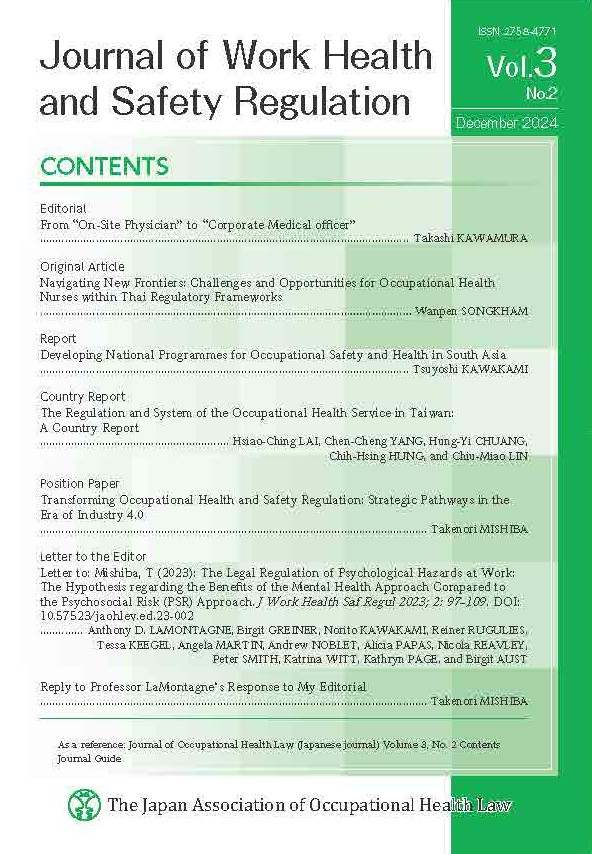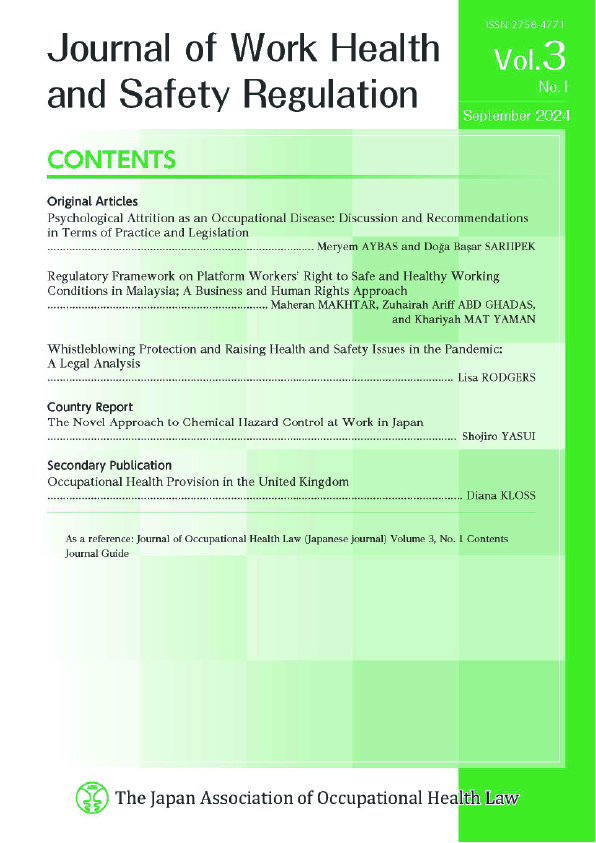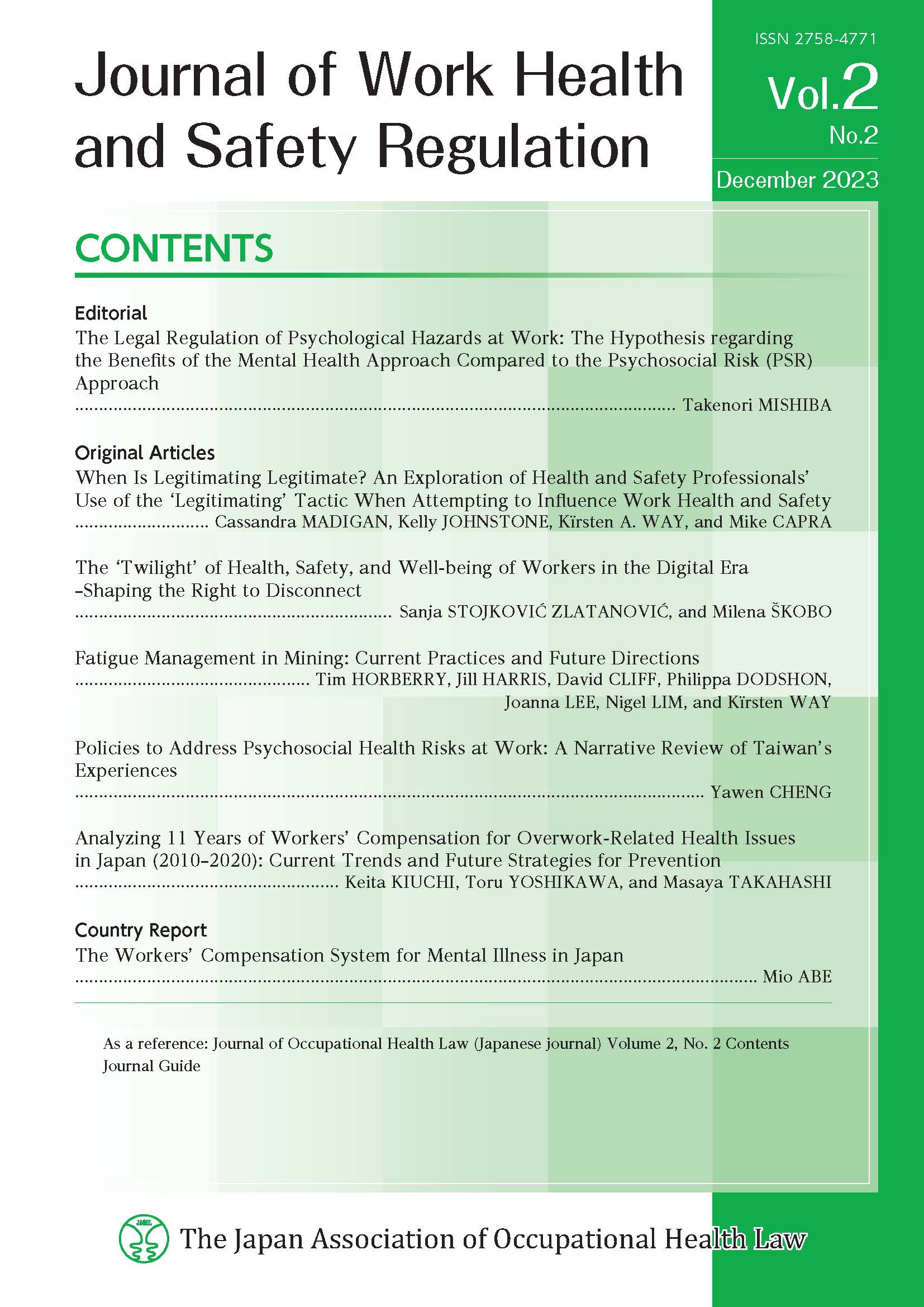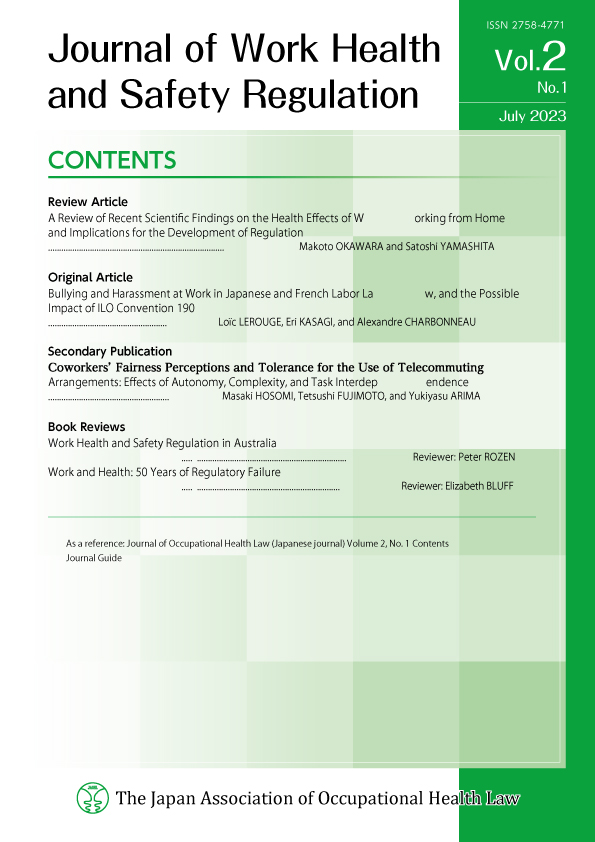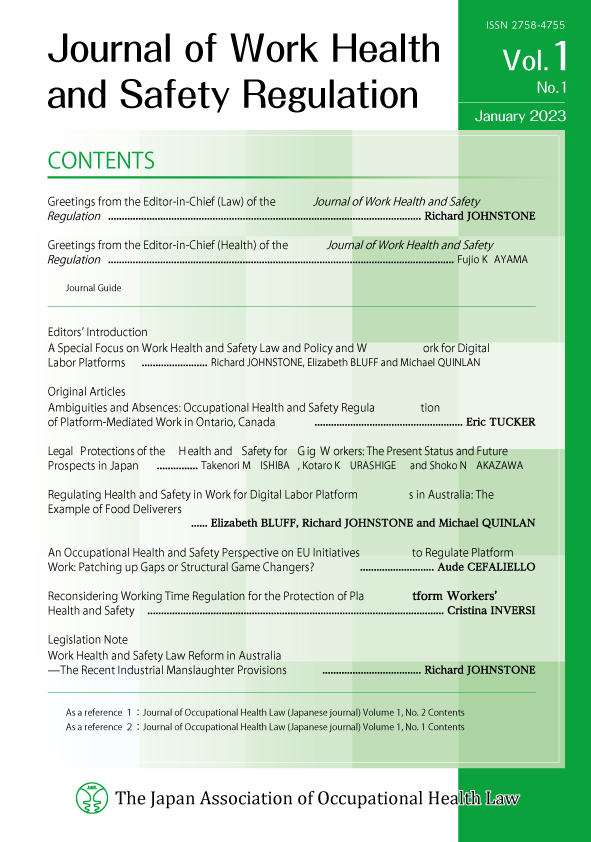Journal guide
Journal guide
JOWHSR can be seen at J-STAGE ![]()
https://www.jstage.jst.go.jp/browse/jaohlev/-char/en
SUBMITTING MANUSCRIPTS
The Journal of Work Health and Safety Regulation (J Work Health Saf Regul : JOWHSR) invites submissions in all fields related to the Work Health Health and Safety Regulation.
Please read the following guidelines and information before proceeding to the submission.
*We changed the name of the journal from “Journal of Occupational Health Law (JOHL)” to “Journal of Work Health and Safety Regulation (JOWHSR)“.
1. EDITORIAL BOARD AND COMMITTEE OF THE JOURNAL
1.1. Editorial Board
Vol.2 No.2-
Editors-in-Chief
Yasuo Suwa
(professor emeritus, Hosei University, Japan)
Fujio Kayama, Health
(professor emeritus, Jichi Medical University, Japan)
Deputy Editor-in-Chief
Tōru Yoshikawa, Health (senior researcher (deputy director), Research Center for Overwork-Related Disorders, National Institute of Occupational Safety and Health, Japan)
Editor
Diana Kloss MBE, Law
(professor, London South Bank University, UK)
Erica Martin, Law
(legal specialist, International Labour Organization, Canada)
Shinichi Ago, Law
(professor, emeritus Kyushu University, ILO Committee of Experts on the Application of Conventions and Recommendations, Japan)
Masaya Takahashi, Health and Policy
(director, Research Center for Overwork-Related Disorders, National Institute of Occupational Safety and Health, Japan)
Maria Karanika-Murray, Health
(professor, Leicester University, UK)
Lisa Rodgers, Law
(associate professor, Leicester University, UK)
Takenori Mishiba, Law
(professor, Kindai University Faculty of Law, Japan)
Administrator
Takenori Mishiba, Law
(professor, Kindai University Faculty of Law, Japan)
-Vol.2 No.1
Editors-in-Chief
Richard Johnstone, Law
(honorary professorial fellow, Melbourne Law School, The University of Melbourne, Australia)
Fujio Kayama, Health
(professor emeritus, Jichi Medical University, Japan)
Deputy Editor-in-Chief
Tōru Yoshikawa, Health (senior researcher (deputy director), Research Center for Overwork-Related Disorders, National Institute of Occupational Safety and Health, Japan)
Editor
Diana Kloss MBE, Law
(professor, London South Bank University, UK)
Administrator
Takenori Mishiba, Law
(professor, Kindai University Faculty of Law, Japan)
Advisor
Masaya Takahashi, Health
(director, Research Center for Overwork-Related Disorders, National Institute of Occupational Safety and Health, Japan)
1.2. Editorial Committee
Chairperson
Akizumi Tsutsumi (professor, Department of Public Health, Kitasato University School of Medicine, Japan)
Deputy Chairperson
Takenori Mishiba (professor, Kindai University Faculty of Law, Japan)
Chiefs
Noritada Katō (occupational (health) physician, Fuji Electric Co., Ltd., Japan)
Masaki Imura (professor, Otemon Gakuin University Faculty of Law, Japan)
Makoto Okawara (full-time lecturer, Department of Environmental Epidemiology, Institute of Industrial Ecological Sciences, University of Occupational and Environmental Health, Japan)
Members
Toshiya Irokawa (professor, Occupational Health, Tohoku University School of Medicine, Japan)
Teruhisa Uwatoko (professor, University Health Center, Kyoto University of Education, Japan)
Hisashi Eguchi (professor, Department of Mental Health, Institute of Industrial Ecological Sciences, University of Occupational and Environmental Health, Japan)
Tōru Yoshikawa (senior researcher (deputy director), Research Center for Overwork-Related Disorders, National Institute of Occupational Safety and Health, Japan)
Yūko Odagiri (lecturer, Public Health, Tokyo Medical University, Japan)
Fujio Kayama (emeritus professor, Jichi Medical University, Japan)
Shōgo Hino (professor, Shukutoku University School of Community Studies, Japan)
Tatsuya Sasaki (associate professor, Nagoya Gakuin University Faculty of Law, Japan)
Takayuki Hara (professor, Aomori Chuo Gakuin University Faculty of Law and Management, Japan)
Kōsuke Mafune (senior lecturer, Department of Mental Health, Institute of Industrial Ecological Sciences, University of Occupational and Environmental Health, Japan)
Hajime Yoshida (director, Tenma Law Office; former visiting professor, Kyoto University, Japan)
Toshihiro Okada (attorniey at law, Japan)
Keiichi Matsuzaki (senior lecturer, Department of Public Health, Kitasato University School of Medicine, Japan)
Yuta Morinaga (professor, Faculty of Economics Department of Management Studies, Sophia University, Japan)
Takehiko Yamada (council member, Occupational Health Promotion Foundation, Japan)
Advisor
Masaya Takahashi (director, Research Center for Overwork-Related Disorders, National Institute of Occupational Safety and Health, Japan)
Click here for the members of board of the Association.
2. JOURNAL POLICY
2.1. Aims and Scope
The Journal of Work Health and Safety Regulation (JOWHSR) is a peer-reviewed multidisciplinary journal of international scope in work health and safety regulation. It is published biannually in English and administered by the Japan Association of Occupational Health Law.
Before submitting your manuscript, please ensure you have read the aims and scope of the journal.
The aim of the journal is to advance academic research and to inform policy debate and decision-making in all aspects of work health and safety regulation, including prevention, compensation, and rehabilitation/return to work.
The Journal is interested in submissions that include analysis of legislative, administrative, or judicial developments in a single country that have transnational implications or that relate to potential international trends; doctrinal (legal analytical) comparisons addressing common work health and safety issues across two or more countries; empirical analyses; case studies; analysis of theoretical, methodological, or historical issues in work health and safety regulation; scholarship on mixed systems of law or of supranational legal regulation; and discussion of economic, social, or cultural aspects of work health and safety regulation and/or the ‘transferability’ of legal rules or policy approaches.
Multidisciplinary and interdisciplinary perspectives on work health and safety regulation – including from occupational health, medicine, sociology, regulatory studies, industrial relations, psychology, social policy, criminology, socio-legal studies, and history – are welcome.
The journal is also interested in submissions that analyze important court decisions (case notes), reports on work health and safety regulation issues (reports) and developments in work health and safety legislation (legislation notes), as well as reviews of books on work health and safety regulation (book reviews). The journal will also publish occasional editorials (including guest editorials) reporting on developments in work health and safety regulation from around the world.
2.2. Area of specialty
1) Basic framework of activities
The greatest characteristic of this association is the orientation towards problem-solving and prevention. Conventionally, laws have been oriented towards resolving disputes that have already occurred. By having its foundation based on the knowledge that is cultivated in such a manner, the Japan Association of Occupational Health Law (JAOHL) combines knowledge from various related fields and seeks to resolve and prevent legal
issues concerning work health and safety. We welcome everything from the latest academic research to practical debates concerning the challenges in the field. In our educational activities, we emphasize the practical legal education of occupational health professionals, such as industrial physicians (Fig. 1).
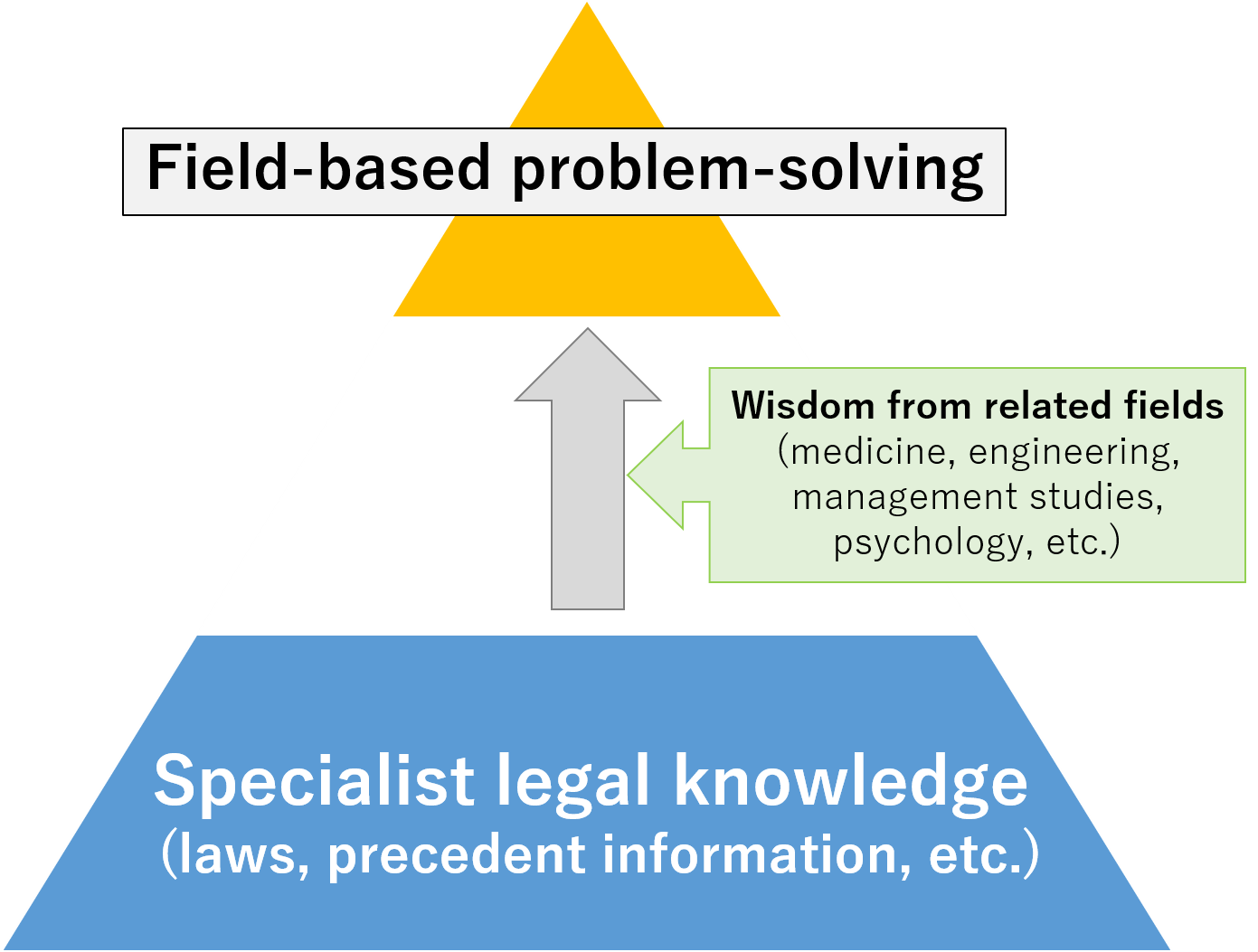
Fig. 1. Basic framework of JAOHL activities
2) Area of specialty toward “field-based problem-solving”
Our area of specialty is aimed toward field-based problem-solving, which can be organized as
shown in Fig. 2. While the horizontal axis represents time, the vertical axis represents perspective, creating the following four quadrants.
(1) Macro-level × prevention
How should legal systems be created to prevent work health and safety problems from occurring?
cf. proposals for work health and safety legislation, etc.
For example, how should the work health and safety of freelancers and teleworkers be regulated, and how should the handling of chemicals with unknown toxicity be regulated.
(2) Macro-level × ex post facto resolution
How should the legal systems and laws at the national level be created to resolve the work health and safety problem?
cf. how should the industrial accident compensation systems work, how should the industrial accident compensation be wound up, etc.
For example, how should the findings of industrial accidents be made for chemical hypersensitivity or hepatitis when the effects of overconsumption of alcohol during work are suspected, and how should the decision to discontinue industrial accident compensation be made in the case of mental disorders, which can last over long terms.
(3) Micro-level × prevention
How should the company rules and systems be created to prevent work health and safety problems from occurring?
cf. the state of company rules and systems that are useful for prevention, etc.
For example, if there are useful examples of decreases in the number of unwell people or trouble through the preparation of new health management regulations, there must be an analysis of their factors and whether they can be expanded.
(4) Micro-level × ex post facto resolution
In order to resolve the work health and safety problems after the fact, how should individual methods and laws be created when the parties go to court?
cf. know-how about out-of-court dispute resolution, theories of appropriate compensation, etc.
For example, if there are strategies that have contributed towards the prevention of disputes at an early stage, when employees suffer unclear health disorders outside work, there must be an analysis of their factors and whether they can be expanded.
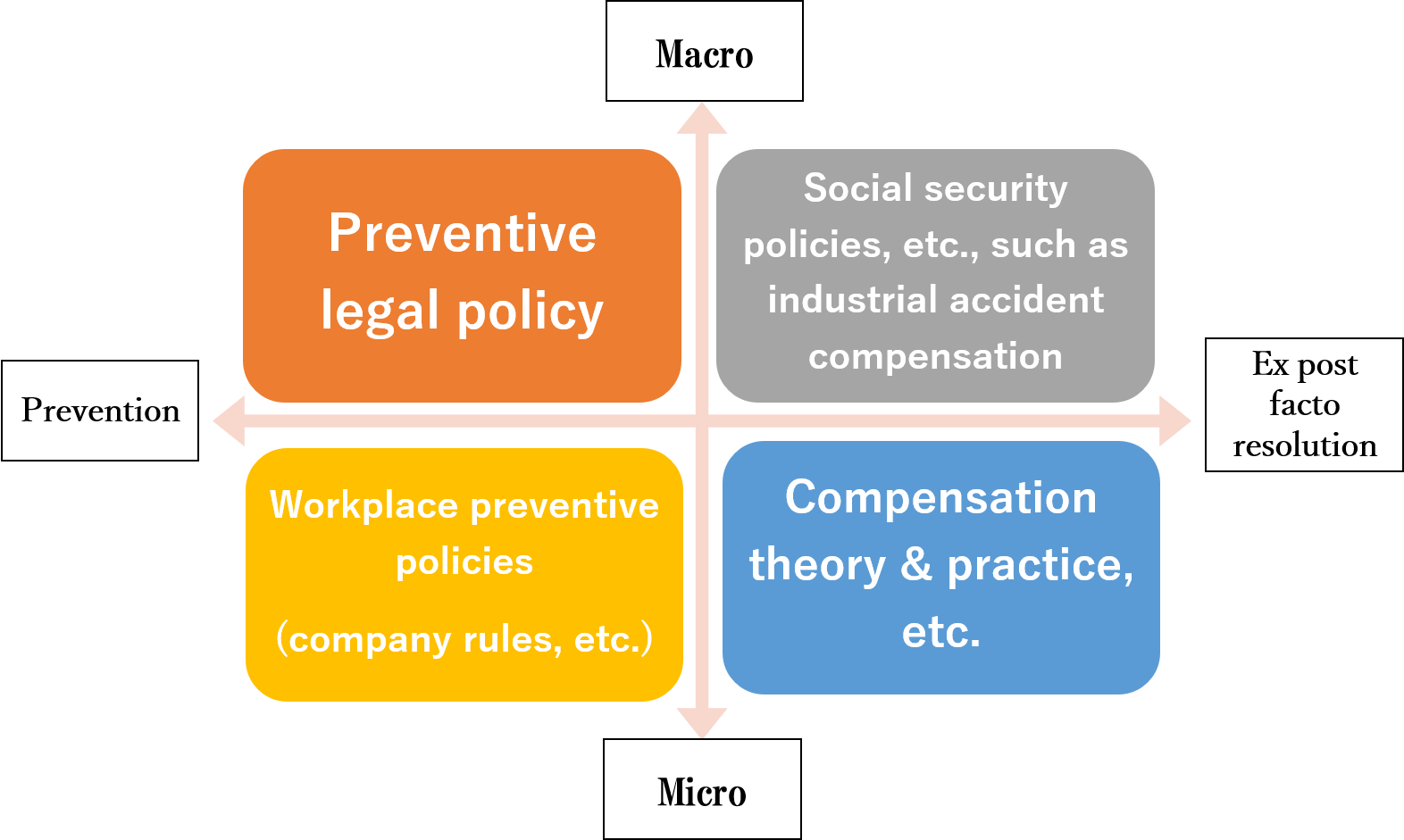
Fig. 2. Organization of field-based problem-solving
The issues that this Association will tackle for the time being
(1) Legal system that encourages collaborative work health and safety by various stakeholders
(2) Diverse and dense work destinations, possible health problems and legal regulations
(3) Measures to ensure health and safety in response to the increase in double-employed and self-employed
(4) Future chemical substance management and the law
(5) Criteria for certifying workers’ injuries and healing of brain/heart diseases and mental disorders based on the evolution of diagnostics and pathology
(6) Scope of application of industrial accident compensation for health disorders other than brain heart disease and mental illness
(7) How to properly handle health information
(8) Appropriate return to work determination
(9) Appropriate way of dealing with employees who have problems with personality and development (including reasonable consideration) in the workplace
(10) Effective countermeasures against harassment
It applies an editorial policy that:
– is committed to a rigorous analysis;
– fosters diversity and equality of opportunity by strongly encouraging submissions in English or Japanese by authors of all generations and from all world regions;
– welcomes manuscripts related to the world of work health and safety regulation from all disciplines and encourages the submission of those with an inter-disciplinary approach;
– welcomes both theoretical and empirically-based studies, as well as comparative and international studies, and country-level studies that explore concepts, trends, and institutions that are of interest to an international audience;
– promotes a style of writing that is accessible to both academics, policy-makers, and a multidisciplinary readership.
Click here for its basic scope.
It applies an editorial policy that:
is committed to a rigorous analysis;
fosters diversity and equality of opportunity by strongly encouraging submissions in English or Japanese by authors of all generations and from all world regions;
welcomes manuscripts related to the world of work health and safety regulation from all disciplines and encourages the submission of those with an inter-disciplinary approach;
welcomes both theoretical and empirically-based studies, as well as comparative and international studies, and country-level studies that explore concepts, trends and institutions that are of interest to an international audience;
promotes a style of writing that is accessible to both academics and policy-makers and a multidisciplinary readership.
2. SUBMISSION
2.1. Submission
Submissions to the JOWHSR should be sent to:
JOWHSR Editorial Office
E-mail: jowhsr-edit[at]je.bunken.co.jp
Please replace [at] to @
2.2. Language
Articles must be submitted in English. Authors are invited to write in a style that is accessible to academics, policy-makers, and a multidisciplinary audience.
2.3. Manuscript Types
The journal publishes Articles, Legislation Notes (notes on new legislation in one or more countries), Reports (notes on significant reports on work health and safety law and policy issues), Case Notes, Book Reviews, and Editorials. Articles, Legislation Notes, notes on Reports, and Case Notes will be peer reviewed.
2.4. Submission declaration statement
All submissions should be accompanied by a statement indicating that they are not under consideration elsewhere or have not already been published, and that they will not be submitted for publication elsewhere without the agreement of the Administrator.
2.5. Conflict of interest statement
Authors must provide a conflict of interest statement on the title page. Authors should disclose any potential sources of conflict of interest. Any interest or relationship, financial or otherwise that might be perceived as influencing an author’s objectivity is considered a potential source of conflict of interest.
If there is a conflict of interest to be declared, it should be stated as in
1. Author X has received financial support from Y Corporation.
2. Author X is an employee of Y Corporation.
If the authors have no conflicts of interest to declare, they must state “The authors have no conflicts of interest to declare.” on the title page at submission.
It is the responsibility of the corresponding author to review this policy with all co-authors. Submitting authors should ensure they liaise with all co-authors to confirm agreement with the final statement. Authors must complete the disclosure form and submit it with the manuscript.
2.6. Funding
Authors should list all funding sources in the acknowledgments section. Authors are responsible for the accuracy of their funder designation.
2.7. Research Ethics statement
Authors of manuscripts describing research involving the participation of humans must confirm that the work was carried out in accordance with the principles embodied in the Declaration of Helsinki, its revisions, and any guidelines approved by the authors’ institutions. Informed consent obtained from research subjects and approval of an Ethics Review Committee must be clearly indicated on the title page. The author must submit the Ethical Consideration Confirmation Form with the manuscript to the editorial office. In the case that an ethical review is not required, the Ethical Consideration Confirmation Form must still be submitted.
2.8. Rights and permissions
Authors must observe the usual rules and practices regarding the reproduction of copyrighted material in their articles. If a manuscript includes previously published material, the authors must obtain permission from the copyright owners and the publisher of the original work to reproduce it. The authors must cite the original work in their manuscript.
2.9. Pre-print policy
This journal will consider for review articles previously available as preprints on noncommercial servers. Authors may also post the submitted version of a manuscript on noncommercial servers at any time. Authors must notify JOWHSR of any preprint related to their manuscript upon submission. Authors are recommended to post a link to the JOWHSR article on the preprint server after the manuscript is accepted.
2.10. Copyright and Open Access
All accepted manuscripts become the property of the JAOHL.
JOWHSR is an Open Access journal where all manuscripts are published subject to the Creative Commons license CC-BY-NC-ND (Attribution-NonCommercial-NoDerivatives). This license allows users to share unmodified articles, non-commercially, as long as appropriate credit is given.
In addition to requiring users to provide attribution to the work, JAOHL prohibits commercial use and modification of the article. For commercial use, users need to contact the society office. Legal background for the license is available at: https://creativecommons.org/licenses/by-nc-nd/4.0/.
Authors must complete and sign the Copyright Transfer Agreement form and submit this after the manuscript is accepted.
2.11. Fees and Charge
There are no submission fees or article processing charges.
3. PREPARING THE SUBMISSION
3.1. Formatting
Main text should be submitted as Word documents in “Times New Roman”, font size 12, double-spaced.
Each new paragraph should be indented except for the first paragraph under a heading. The tables must submit as a separate Excel or MS Word File containing text data, not as images. Submit figures, photographs, graphs, or diagrams in MS Word, PowerPoint, JPEG, or TIFF. Figures should be of high enough resolution for direct reproduction for printing, and the resolution of the figure should be at least 300 dpi.
3.2. Arrangement and length of manuscript
Articles should be between approximately 3,000 and 10,000 words long, with an abstract of no more than 250 words. References, tables, and figures are excluded from the number of words.
The manuscript should be submitted in separate files for the following parts: (1) title page; (2)main text; (3) tables, figures, appendices, and supporting information. Legislation Notes, Reports, Case Notes and Book Reviews should be between approximately 1,500 and 7,000 words long.
Title page
The title page should contain:
i. A title containing no abbreviations;
ii. The full names of the author(s), specifying the name of the corresponding author, i.e. the person who will have the primary responsibility for communicating with the journal during the manuscript submission, peer review, and publication process.
iii. The institutional affiliation(s) where the work was conducted and e-mail address(es) of the author(s).
iv. Acknowledgments. Besides indicating any contributions from persons who do not meet the criteria for authorship, any financial support should be mentioned.
v. Submission declaration statement, see section 2.4. above.
vi. Funding, see section 2.6. above.
vii. Conflict of interest statement, see section 2.5. above.
viii. Information on rights and permissions obtained to reproduce material from other sources, see section 2.8. above.
Main text
As articles are peer-reviewed, the main text should not include any information that might identify the authors.
The main text should be presented in the following order:
i. Classification (Articles, Legislation Notes, Reports, Book Reviews, Editorials);
ii. Title;
iii. Abstract: describing the aims, methods, scope of analysis, results, and conclusions;
iv. Keywords (between 4 and 8);
v. Running title (60 characters or less);
vi. Main text (may be omitted depending on the type of manuscript);
vii. List of references.
viii. Legends
Tables, figures, appendices, and supporting information
Tables and figures should be included in the text and also supplied in a separate file. For submission, they should be supplied as separate files but referred to in the text. If data, scripts or other artifacts used to generate the analyses presented in the manuscript are available via a publicly available data repository, authors should include a reference to the location of the material within their manuscript.
4. HOUSE STYLE
4.1. Reference
JOWHSR is a multidisciplinary journal, and authors can choose from the following two citation styles, which are familiar to the author’s academic field. Authors are responsible for verifying all citations and quotations in the text, and the list of references before the submission of the manuscript. Incorrect surnames, journal/book titles, publication year, and pagination may decrease discoverability.
References in the law field
References follow the Chicago Manual of Style “author–date” system in the law field. All references should be listed in Reference list entries (in alphabetical order) and In-text citations. For more information on this citation style, please refer to the Chicago Manual of Style.
Reference examples follow:
– Journal article
Reference list entries
Malik, Radosław, Anna Visvizi and Małgorzata Skrzek-Lubasińska. 2021. “The Gig Economy: Current Issues, the Debate, and the New Avenues of Research.” Sustainability 13, no. 9: 5023–5043.
In-text citations
…… and journalists (Malik, Visvizi, and Skrzek-Lubasińska 2021).
– Book
Reference list entries
Franklin, Paula, Pierre Bérastégui, Aude Cefaliello, Tony Musu, and Marian Schaapman. 2021. “Occupational Health and Safety Inequalities in the EU.” In Benchmarking Working Europe 2021: Unequal Europe, edited by Nicola Countouris, Romuald Jagodzinski, and Sotiria Theodoropoulou, 133–155. Brussels: European Trade Union Institute.
In-text citations
…… to inequal protection of workers (Franklin et al. 2021, 143).
– Internet Document
Reference list entries
UFCW Canada (United Food and Commercial Workers Canada). 2022. “Benefits.” Accessed September 24, 2022. https://uber.ufcw.ca/en/driver-resources/benefits.
In-text citations
…… of platform work (UFCW Canada 2022).
References in the health field
References follow the AMA Manual of Style for authors in the health field. All references should be consecutively numbered in order of appearance and listed as completely as possible. All in-text citations should be given in consecutive order using Arabic superscript numerals. For more information on this citation style, please refer to the AMA Manual of Style. Reference examples follow:
– Journal article
Hosohata K, Mise N, Kayama F, Iwanaga K. Augmentation of cadmium-induced oxidative cytotoxicity by pioglitazone in renal tubular epithelial cells. Toxicol Ind Health. 2019; 35: 530–536.
– Book
Mishiba T. Workplace Mental Health Law-Comparative Perspectives, London, Routledge, Taylor and Francis, 2021.
– Internet Document
Ministry of Health. Labour and Welfare. Summary of Results of the 2022 Occupational Safety and Health Survey (Fact-finding Survey) [in Japanese]. Ministry of Health, Labour and Welfare. Published 2023. https://www.mhlw.go.jp/toukei/list/r04-46-50b.html [Accessed March 21, 2024]
4.2. Legends
The list of legends for figures, illustrations, appendices, and supporting information should be after the References section in the text document. Each legend should have a brief description and sufficient information for interpretation of the corresponding figure or other material.
4.3. Tables and figures
Tables and figures should be numbered consecutively, in order of appearance in the text. Authors should indicate a source under figures and tables, in particular indicating the source of any data used for calculations, regardless of whether this has already been explained in the text.
4.4. Lay-out and general style points
– Headings and subheadings
Titles, headings, and sub-headings should be numbered (following the format Ñ, 1.A, 1.A.(i),) to indicate the level of importance.
– Abbreviations, acronyms, and contractions
In general, terms and names should not be abbreviated unless they are used repeatedly (more than three times) and the abbreviation is helpful to the reader. Where abbreviations are used, each one should be expanded on its first use, followed by the abbreviation or acronym in parentheses. Thereafter, the abbreviation or acronym should be used rather than the full term.
– Latin phrases and foreign expressions
Where these are used, they should be italicized unless so common that they have become wholly absorbed into the everyday language (e.g. bona fide). Examples of the normal rule: res ipsa loquitur amicus curiae
– Capitalization
In articles, only the first letter of the title, subtitle, and headings should be capitalized, as well as any other words that would ordinarily be capitalized. Following colons and en dashes, the first letter of subtitles is also capitalized. E.g.: Welfare and labor market regimes: A review of earlier work
In source citations, however, regardless of the capitalization of the original, English language titles of works are capitalized except for articles, conjunctions, and prepositions (“regarding”, “concerning” and “respecting” are treated as prepositions), unless they are the first or last word of a title. Initial capitals should be used for the short titles of legislative texts and international instruments.
– Page references
Page references should be set out in full, e.g. pp. 123–124 (not 123–4). It is preferable to cite a precise range of pages rather than using expressions such as “p. 218 ff.”
5. EDITORIAL POLICIES AND ETHICAL CONSIDERATIONS
5.1. Peer-review and acceptance
All manuscripts undergo screening by the JOWHSR Editor-in-Chief, Managing Editor, and the Editorial Board based on the JOWHSR’s editorial policy. Those manuscripts which pass this screening stage are submitted to a double-blind peer-review process and, if accepted, to editing and translation.
5.2. Publication ethics
Authors should observe high standards with regard to publication ethics as outlined by the Committee on Publication Ethics (COPE). Any cases of ethical misconduct will be dealt with in accordance with the COPE guidelines (https://publicationethics.org/).

